| Srl | Item |
| 1 |
ID:
098368
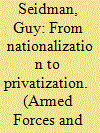

|
|
|
|
|
| Publication |
2010.
|
| Summary/Abstract |
In recent years the use of private military contractors to execute national security tasks in the U.S. military has finally come under public scrutiny. The main policy question is in three parts: What is the proper division of labor between the public and private sectors? Who decides which sector performs a specific task? If private operatives perform tasks that typically fall on the public side (combat, interrogation), what is the public oversight over the private actors, and how can they be held accountable for wrongdoings? In this article these questions are addressed in relation to the privatization process in the Israeli Defense Forces (IDF). The article has four parts: the first suggests that the Israeli baseline is unique as the IDF has historically been entrusted with a wide array of national-civilian missions; the second explains the economic realities that probably lie behind the privatization efforts; the third describes the slow and cautious privatization process currently under way; the fourth suggests that while there is little public debate, there is civilian oversight, there are some publicly exposed rationales, and there is public support in letting the IDF, the most trusted part of the executive branch, control the process.
|
|
|
|
|
|
|
|
|
|
|
|
|
|
|
|
| 2 |
ID:
175011
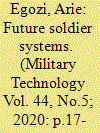

|
|
|
| 3 |
ID:
138579
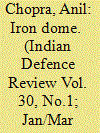

|
|
|
|
|
| Summary/Abstract |
The name ‘Iron Dome’ evokes an image of a protective bubble. The Iron Dome is an Israeli ground based, truck towable, short-range, ground-to-air air defence system in operation since 2011. Currently operated only by Israel and Singapore, it has been operationally tested in Operation Pillar of Strength in November 2012 and Operation Protective Edge, the two conflicts against Hamas in Gaza. It is designed and manufactured jointly by Rafael Advanced Defense Systems (Rafael) and Israel Aerospace Industries Ltd (IAI), in close coordination with Israeli Defence Forces (IDF). At a unit cost of $50 million per battery, every missile launch costs approximately $50,000. With a weight of 90 kg, the missile is three metres long and is carried in groups of 20 in each launcher. The warhead is believed to carry 11 kilograms or 24 pounds of high explosives. It is designed to destroy short range rockets and up to 155 mm artillery shells during day or night, at distances between four to 70 km. It can be operated in all weather conditions including in fog, dust storm, low clouds and rain. The lethal range may one day be increased to 250 km.
|
|
|
|
|
|
|
|
|
|
|
|
|
|
|
|
| 4 |
ID:
118473
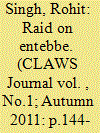

|
|
|
| 5 |
ID:
151811
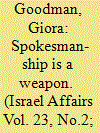

|
|
|
|
|
| Summary/Abstract |
The October 1973 war severely tested the relations of the Israeli government and military authorities with the national and foreign news media. Much has been said about the role of government and military press control and news management in muting and failing to bring to public notice the increasing signs of Egyptian and Syrian intentions before the war’s sudden outbreak. This article will focus on Israeli army news management during the war itself, a complex military campaign which opened in great disarray and with setbacks. Largely based on recently available archive material shedding light on the IDF’s wartime press work and on discussions and decision-making in the IDF high command, the paper examines the ways in which government and military sought to control and manage news reporting in the domestic and foreign media. It charts in particular the reasons for the growing distrust of statements by Israeli leaders and officially disseminated information in the early stages of the war, as well as the difficulties of the military apparatus in controlling the media, even when defeat turned eventually into victory. More than 40 years later, the issues discussed remain pertinent.
|
|
|
|
|
|
|
|
|
|
|
|
|
|
|
|